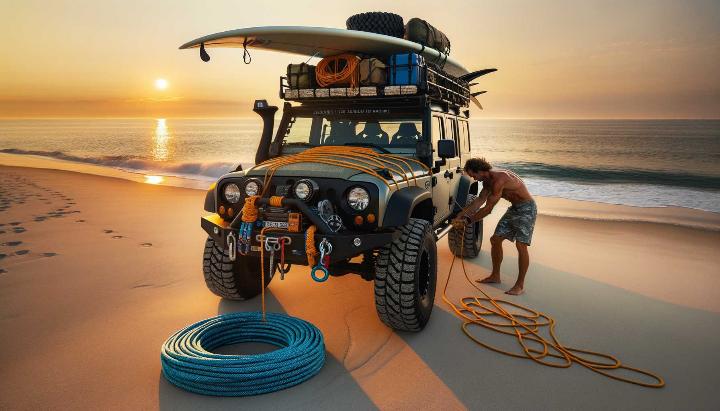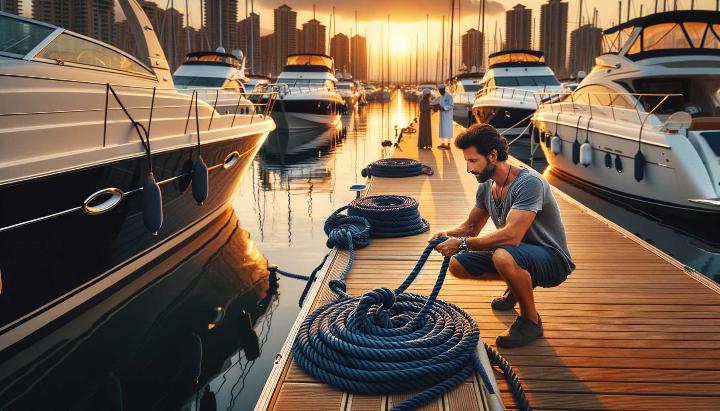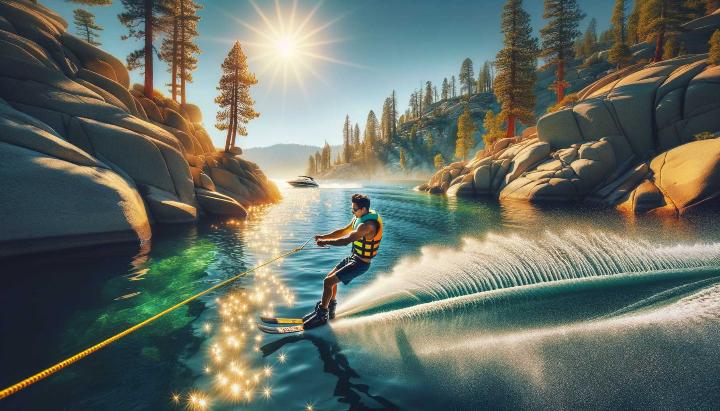Have you ever found yourself in a sticky situation, whether it's a 4x4 bogged down in the Outback or a yacht battling choppy seas? The difference between triumph and disaster often comes down to one crucial element: the humble rope. But not all ropes are created equal. In the world of offroad adventures and marine escapades, selecting the right rope can be the linchpin of success—or the weakest link in your chain of preparation.
From the rugged terrains of the Australian bush to the unpredictable waters of the Pacific, mastering the art of rope selection is essential for any serious adventurer. In this comprehensive guide, we'll unravel the mysteries of ropes and more, exploring the types of ropes and their uses across both offroad and marine environments. Whether you're a weekend warrior or a seasoned pro, understanding the kinds of ropes and their uses will not only enhance your outdoor experiences but could also save your life in critical moments.
Join us as we delve into the world of synthetic marvels and time-tested natural fibres, discovering how the right rope can transform your next expedition from ordinary to extraordinary. Buckle up, mates—it's time to rope in some knowledge that'll keep you ahead of the game, whether you're conquering sand dunes or riding the waves!
Types of Ropes and Their Characteristics
When it comes to offroad adventures or marine escapades, choosing the right rope can make all the difference. As an avid outdoorsman, I've learned that understanding the various types of ropes and their unique properties is crucial for safety and efficiency. Let's dive into the world of ropes and explore the main categories that you'll encounter in your outdoor pursuits.
Natural vs. Synthetic Rope Materials
The age-old debate of natural versus synthetic ropes continues to this day. Each type has its strengths and weaknesses, making them suitable for different applications. Let's break it down:
- Natural ropes have been used for centuries and include materials like cotton, manila, hemp, and sisal. They're biodegradable and offer a classic feel, but they're generally less durable than their synthetic counterparts.
- Synthetic ropes are the modern marvels of the rope world. Made from materials like nylon, polyester, and polypropylene, they offer superior strength, durability, and resistance to the elements.
Did You Know?
Synthetic ropes can be up to five times stronger than natural ropes of the same diameter!
Common Rope Constructions and Their Uses
The way a rope is constructed plays a significant role in its performance. Here are the main types you'll encounter:
- Twisted ropes are the traditional style, offering good strength and flexibility. They're great for general-purpose use but tend to unravel when cut.
- Braided ropes are more resistant to kinking and are often used in marine applications. They come in single braid (hollow core) or double braid (braided core and cover) varieties.
- Kernmantle ropes feature a strong inner core protected by a woven outer sheath. These are commonly used in climbing and rescue operations due to their excellent strength-to-weight ratio.
When choosing a rope for offroad or marine use, consider factors like strength, durability, UV resistance, and stretch. For example, a low-stretch rope might be perfect for securing cargo, while a more elastic option could be better for towing to absorb sudden shocks.

Remember, the right rope can be a lifesaver in challenging situations. Whether you're winching a vehicle out of a mud pit or securing your boat in choppy waters, knowing your ropes is essential. In the next section, we'll delve deeper into specific rope types for offroad and marine applications, so stay tuned!
Kinds of Ropes and Their Uses
As an avid outdoorsman and marine enthusiast, I've come to appreciate the incredible versatility of different rope types. Whether you're tackling rugged terrain or navigating choppy waters, understanding the unique characteristics of various ropes can make all the difference in your adventures. Let's dive into the fascinating world of ropes and explore how they can enhance your offroad and marine experiences.
Static Ropes for Rigging and Anchoring
When it comes to setting up a solid anchor point or creating a reliable rigging system, static ropes are your go-to choice. These low-stretch ropes are designed to maintain their length under load, providing stability and security in various applications.
- Offroad use: Perfect for winch extension lines and creating anchor points for vehicle recovery.
- Marine applications: Ideal for mooring lines and setting up pulley systems on boats.
I remember using a static rope to create a makeshift winch extension during a particularly challenging off-road expedition. Its unwavering strength gave us the confidence to tackle even the toughest obstacles.
Dynamic Ropes for Shock Absorption and Safety
In contrast to their static counterparts, dynamic ropes are designed to stretch under load, absorbing shock and reducing the impact of sudden forces. This characteristic makes them invaluable in situations where safety is paramount.
- Offroad use: Excellent for recovery straps and tow ropes, reducing the risk of vehicle damage during sudden stops or starts.
- Marine applications: Crucial for docking lines and anchor rodes, helping to absorb the shock of waves and wind.
Always inspect your dynamic ropes for signs of wear and tear. The stretching ability can diminish over time, compromising safety.
Tow Ropes for Vehicle Recovery and Towing
When you're out on the trails, having a reliable tow rope can be a lifesaver. These ropes are specifically designed to handle the high loads and sudden forces associated with vehicle recovery and towing.
- Material matters: Look for synthetic ropes made from materials like nylon or polyester for their strength and durability.
- Length considerations: A tow rope should be long enough to provide a safe distance between vehicles, typically around 20-30 feet.
I once had to use a tow rope to help a fellow off-roader out of a sticky situation. The rope's elasticity absorbed the initial jerk, making the recovery smooth and preventing any damage to either vehicle.
Mooring Lines for Securing Boats and Marine Vessels
When it comes to marine applications, mooring lines play a crucial role in keeping your vessel secure. These ropes need to withstand constant exposure to water, UV rays, and varying tensions.
- Material choice: Nylon is a popular choice for its strength and ability to stretch, absorbing shocks from waves and wind.
- Size matters: The diameter of your mooring line should be appropriate for your boat's size and weight.

Whether you're securing your boat at the marina or anchoring offshore, choosing the right mooring line can mean the difference between a peaceful night's sleep and a stressful ordeal.
As we've explored, different ropes serve unique purposes in offroad and marine environments. By understanding their characteristics and applications, you'll be better equipped to choose the right rope for your next adventure. Remember, the key to mastering ropes lies in practice and experience. So get out there, put your knowledge to the test, and enjoy the confidence that comes with being well-prepared!
Selecting the Right Rope for Offroad Use
When it comes to offroad adventures, having the right rope can be the difference between a successful recovery and a frustrating ordeal. As an avid off-roader, I've learned the importance of choosing the proper rope through both triumphs and mishaps. Let's dive into the crucial factors you need to consider when selecting a rope for your offroad escapades.
Understanding Kinetic Recovery Ropes
Kinetic recovery ropes have revolutionised vehicle recovery in offroad situations. These marvels of engineering are designed to stretch and recoil, absorbing the shock of a sudden pull and reducing the risk of damage to both vehicles involved in the recovery process.
- Energy absorption: Kinetic ropes can stretch up to 30%, storing energy and then releasing it to help "snap" a stuck vehicle free.
- Reduced shock load: The stretching action significantly reduces the initial shock on both vehicles, making for a smoother and safer recovery.
- Versatility: These ropes work well in various terrains, from muddy bogs to sandy dunes.
I remember the first time I used a kinetic recovery rope to pull a mate's 4x4 out of a particularly nasty mud pit. The way the rope stretched and then snapped back, effortlessly popping the vehicle free, was nothing short of impressive. Explore the advantages of using nylon ropes for off-road adventures.
Determining the Correct Rope Strength
Choosing a rope with the right strength is crucial for safe and effective vehicle recovery. The golden rule is to select a rope with a Minimum Breaking Strength (MBS) that's 2-3 times your vehicle's gross weight.
To calculate the required rope strength, use this formula: Rope MBS = Vehicle Gross Weight x 2.5
For example:
- SUV (2,500 kg): Rope MBS should be at least 6,250 kg
- Large 4x4 truck (3,500 kg): Rope MBS should be at least 8,750 kg
Remember, it's always better to err on the side of caution and choose a rope with a higher breaking strength than you think you'll need.
Key Features of Quality Offroad Ropes
When shopping for offroad recovery ropes, keep an eye out for these essential features:
- Material: Nylon is the go-to choice for its excellent strength-to-weight ratio and ability to absorb shock. It's also resistant to UV rays and chemicals, making it perfect for outdoor use.
- Diameter: Thicker ropes generally offer higher breaking strengths, but they're also heavier and less flexible. For most 4x4 vehicles, a rope diameter between 24mm and 32mm is ideal.
- Protective sleeve: Look for ropes with a durable protective sleeve at the ends to prevent fraying and extend the rope's lifespan.
- Colour-coding: Some manufacturers use different colours to indicate the rope's strength, making it easier to choose the right rope at a glance. Learn more about different types of protective sleeves and color coding in high-performance ropes.

Choosing the right rope for offroad use doesn't have to be a daunting task. By understanding kinetic recovery ropes, calculating the correct strength, and looking for key quality features, you'll be well-equipped to handle whatever challenges the trail throws your way. Remember, a quality rope is an investment in your safety and peace of mind during offroad adventures. Consider your specific needs when selecting a rope for offroad usage. Explore iRopes collections for professional off-road applications.
Have you ever had a memorable vehicle recovery experience? What type of rope did you use, and how did it perform? Share your stories in the comments below – your experiences could help fellow off-roaders make informed decisions about their recovery gear!
Choosing the Best Marine Rope for Your Boat
As a seasoned sailor, I've learned that selecting the right rope for your boat is crucial for safety, performance, and peace of mind on the water. Whether you're mooring your vessel, setting anchor, or rigging your sails, the type of rope you choose can make all the difference. Let's dive into the world of marine ropes and discover how to select the perfect one for your nautical needs.
Types of Marine Ropes and Their Properties
When it comes to marine ropes, three main materials dominate the market: nylon, polyester, and polypropylene. Each has its unique properties that make it suitable for different applications on your boat.
- Nylon rope is the go-to choice for docking and mooring lines. Its impressive strength-to-weight ratio and ability to stretch make it perfect for absorbing shock from waves and wind. I've found that nylon ropes provide that extra peace of mind when securing my boat in choppy waters.
- Polyester rope excels in applications where low stretch is crucial. It's incredibly durable and maintains its strength even when wet, making it ideal for halyards and sheets on sailboats. During a recent regatta, I was grateful for the precise control offered by our polyester sheets.
- Polypropylene rope is lightweight and buoyant, making it perfect for water ski tow ropes and other applications where flotation is necessary. While not as strong as nylon or polyester, it's an affordable option for specific uses.

Selecting Rope for Specific Marine Applications
Choosing the right rope for each application on your boat is essential for optimal performance and safety. Here's a quick guide to help you make the best choice:
- Anchoring: Opt for a nylon rope with a diameter appropriate for your boat's size. The stretch in nylon helps absorb shock from waves and wind, reducing strain on your boat and anchor.
- Mooring lines: Nylon is again the top choice here. Look for double-braid construction for added strength and durability. I always keep a set of high-quality nylon mooring lines on board for secure docking.
- Towing: A floating polypropylene rope is ideal for towing water toys or small boats. Its buoyancy prevents it from getting tangled in propellers.
- Running rigging: For sailboats, polyester ropes are perfect for halyards and sheets due to their low stretch and high strength. During my last sailing trip, the precise control offered by our polyester running rigging made a noticeable difference in our boat's performance.
Remember to always check your ropes for signs of wear and replace them as needed. UV exposure and salt water can degrade ropes over time, compromising their strength and reliability.
When selecting marine ropes, consider factors such as UV resistance, water absorption, and abrasion resistance. These properties can significantly affect the rope's performance and longevity in marine environments.
By choosing the right rope for each application on your boat, you'll ensure safer, more enjoyable outings on the water. Have you had any experiences where having the right (or wrong) rope made a significant difference on your boating adventures? Share your stories in the comments below – your insights could help fellow boaters make better choices for their marine rope needs!
```htmlThe right choice of ropes is indispensable for successful offroad and marine adventures. Delving into the world of ropes and more, you'll explore various types of ropes and their uses to enhance safety and performance. Natural fibres like horse and manila compete with synthetic champions such as nylon, which shines in offroad scenarios. Offroad enthusiasts will find kinetic recovery ropes invaluable, while marine adventurers benefit from mooring lines. Recognising different kinds of ropes and their uses empowers you to tackle hurdles with confidence, whether you're navigating muddy trails or choppy waters.
Discover Custom Rope Solutions for Your Needs
Above, you’ll find our contact form where you can inquire about bespoke rope solutions. Whether you need ropes for specific offroad or marine purposes, iRopes offers tailored, high-quality products to suit every situation. Don't miss out on ensuring your next adventure is both safe and efficient with the perfect ropes at hand.
```